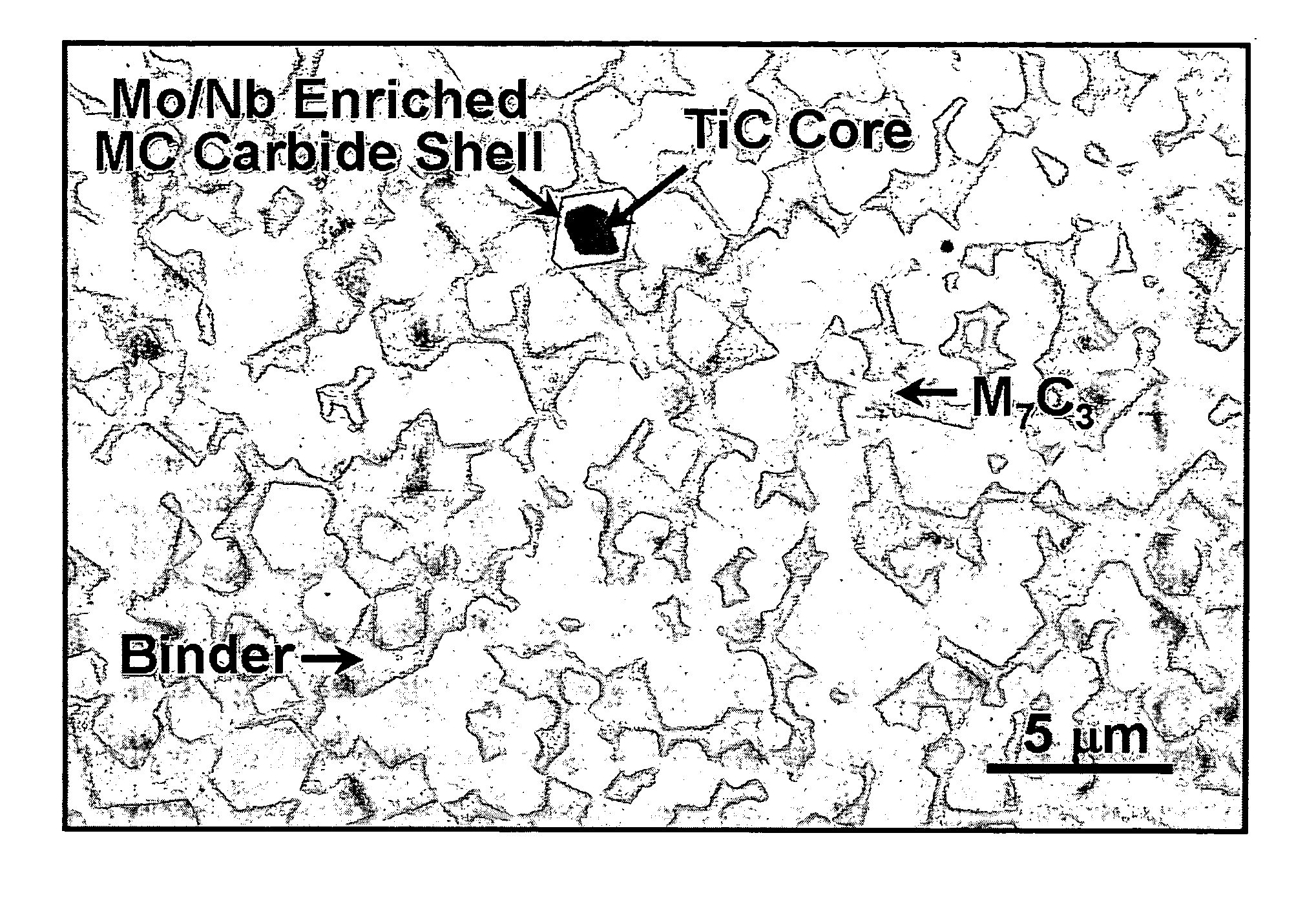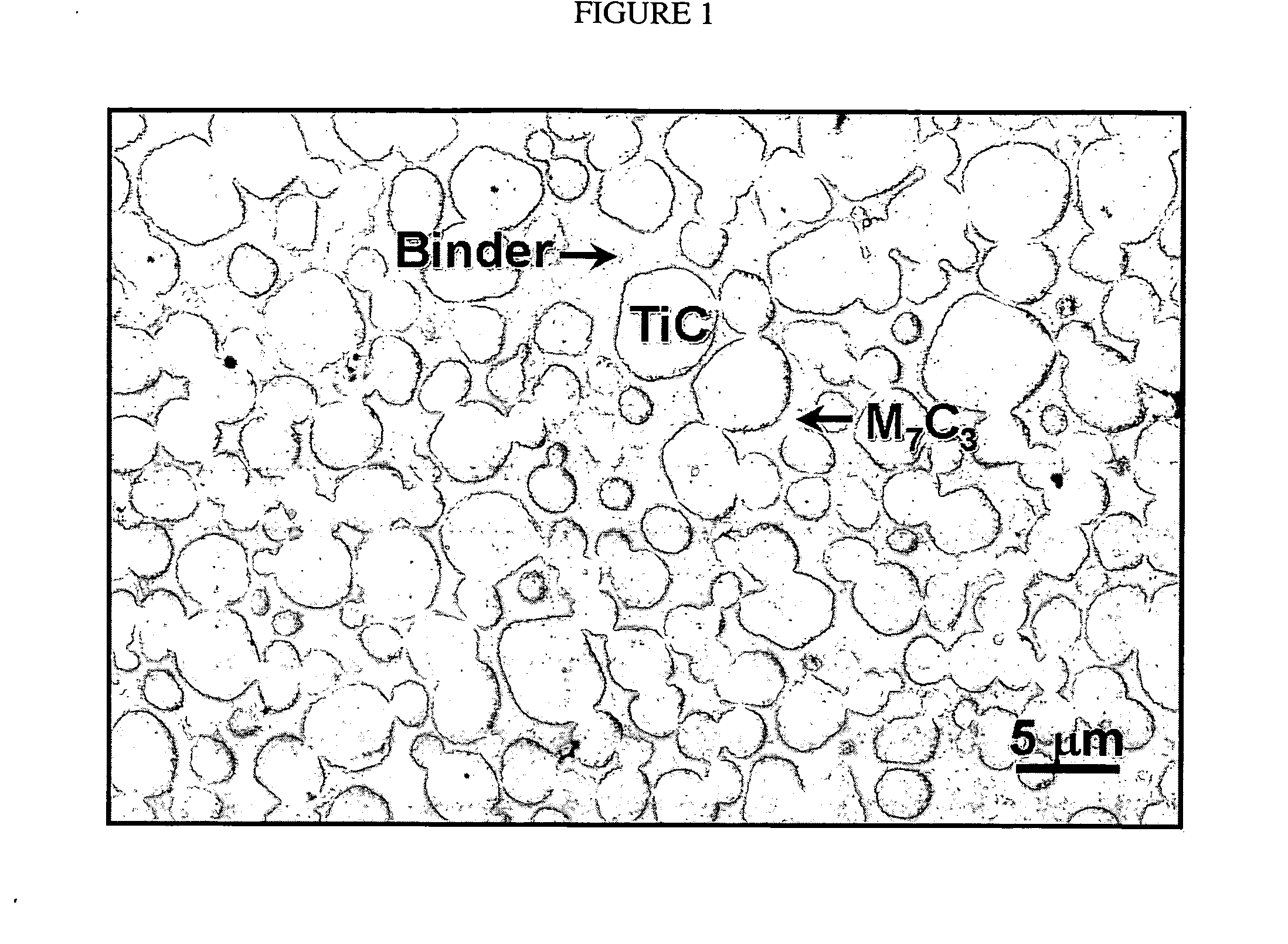Advanced erosion resistant carbide cermets with superior high temperature corrosion resistance
- Summary
- Abstract
- Description
- Claims
- Application Information
AI Technical Summary
Benefits of technology
Problems solved by technology
Method used
Image
Examples
example 1
[0045] 70 vol % of 1.1 .mu.m average diameter of TiC powder (99.8% purity, from Japan New Metals Co., Grade TiC-01) and 30 vol % of 6.7 .mu.m average diameter 347 stainless steel powder (Osprey Metals, 95.0% screened below -16 .mu.m) were dispersed with ethanol in high density polyethylene (HDPE) milling jar. The powders in ethanol were mixed for 24 hours with yttria toughened zirconia (YTZ) balls (10 mm diameter, from Tosoh Ceramics) in a ball mill at 100 rpm. The ethanol was removed from the mixed powders by heating at 130.degree. C. for 24 hours in a vacuum oven. The dried powder was compacted in a 40 mm diameter die in a hydraulic uniaxial press (SPEX 3630 Automated X-press) at 5,000 psi. The resulting green disc pellet was ramped up to 400.degree. C. at 25.degree. C. / min in argon and held at about 400.degree. C. for 30 min for residual solvent removal. The disc was then heated to 1450.degree. C. at 15.degree. C. / min in argon and held at about 1450.degree. C. for 2 hours. The te...
example 2
[0051] The procedure of Example 1 was followed using 70 vol % of 1.1 .mu.m average diameter of TiC powder (99.8% purity, from Japan New Metals Co., Grade TiC-01) and 30 vol % of 15 .mu.m average diameter Inconel 718 powder, 100% screened below -325 mesh (-44 .mu.m).
[0052] The resulting cermet comprised:
[0053] i) 74 vol % metal ceramic with average grain size of 411m, in which 30 vol % is a TiC core and 44 vol % is Nb / Mo / Ti carbide shell, where M=8Nb:4Mo:88Ti in wt %
[0054] ii) 4 vol % M.sub.7C.sub.3 with average grain size of 1 .mu.m, where M=62Cr:30Fe:8Ti in wt %
[0055] iii) 22 vol % Cr-depleted binder
[0056] FIG. 2 shows the TiC core having a Nb / Mo / Ti carbide shell and the M.sub.7C.sub.3 reprecipitate phase.
example 3
[0057] The procedure of Example 1 was followed using 70 vol % of 1.1 .mu.m average diameter of TiC powder (99.8% purity, from Japan New Metals Co., Grade TiC-01) and 30 vol % of 15 .mu.m average diameter Inconel 625 powder, 100% screened below -325 mesh (-33 .mu.m).
[0058] The resulting cermet comprised:
[0059] i) 74 vol % is metal ceramic phase with average grain size of 4 .mu.m, in which 24 vol % is a TiC core and with 50 vol % is Mo / Nb / Ti carbide shell, where M=7Nb:10Mo:83Ti in wt %
[0060] ii) 4 vol % M.sub.7C.sub.3 with average grain size of 1 .mu.m, where M=60Cr:32Fe:8Ti in wt %
[0061] iii) 22 vol % Cr-depleted alloy binder.
PUM
| Property | Measurement | Unit |
|---|---|---|
| Angle | aaaaa | aaaaa |
| Temperature | aaaaa | aaaaa |
| Weight | aaaaa | aaaaa |
Abstract
Description
Claims
Application Information
 Login to View More
Login to View More - R&D
- Intellectual Property
- Life Sciences
- Materials
- Tech Scout
- Unparalleled Data Quality
- Higher Quality Content
- 60% Fewer Hallucinations
Browse by: Latest US Patents, China's latest patents, Technical Efficacy Thesaurus, Application Domain, Technology Topic, Popular Technical Reports.
© 2025 PatSnap. All rights reserved.Legal|Privacy policy|Modern Slavery Act Transparency Statement|Sitemap|About US| Contact US: help@patsnap.com



